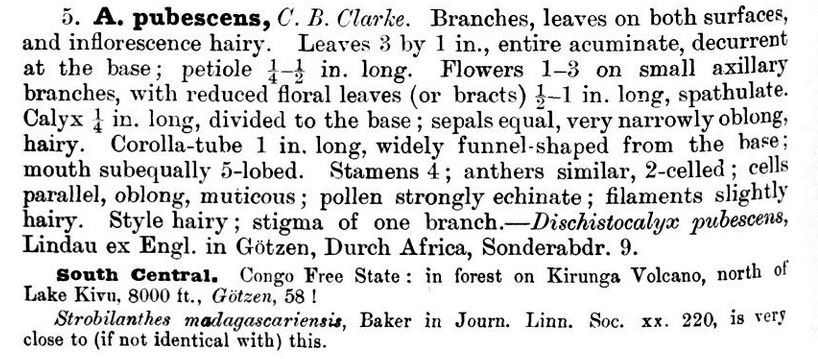Acanthopale Pubescens on:
[Wikipedia]
[Google]
[Amazon]
''Acanthopale pubescens'' is a

species
In biology, a species is the basic unit of classification and a taxonomic rank of an organism, as well as a unit of biodiversity. A species is often defined as the largest group of organisms in which any two individuals of the appropriate s ...
of the genus ''Acanthopale
''Acanthopale'' is a plant genus in the Acanthaceae plant family. The genus name is based on the classic Greek words for thorn ''ákantha'' and stake ''palum''. Some species in the genus are cultivated as ornamental plant
Ornamental plants o ...
'' of the family Acanthaceae
Acanthaceae is a family (the acanthus family) of dicotyledonous flowering plants containing almost 250 genera and about 2500 species. Most are tropical herbs, shrubs, or twining vines; some are epiphytes. Only a few species are distributed in te ...
. The species occurs in East and Southern Africa (except in South Africa). ''Acanthopale pubescens''is also known as Herayye in Ethiopia.
Description
''Acanthopale pubescens'' is an erect, soft-wooded shrub or a shrubbery herb that can grow up to 2.5 m tall. The leaves are oppositely arranged and the largest leaves are 8–24 cm long, ovate to elliptic with distinct drip-tip and are narrow at the base and apex. The Flowers are hermaphroditic and have radial symmetry and the Inflorescences are lateral with terminal racemose heads and hairy on the inside. The flower is white with purple marking and the corolla is hairy on the outside. Corollas can be up to 3 cm long and vary in size. The corolla consists of the whorl of petals. The capsule is 11–14 mm long and seeds are ellipsoid to circular, and range from 3–4 mm.Taxonomical history
The species was first but incorrectly described byGustav Lindau
Gustav Lindau (2 May 1866 in Dessau – 10 October 1923 in Berlin), was a German mycologist and botanist.
Biography
Gustav Lindau studied natural history in Heidelberg and Berlin, where he studied under Simon Schwendener (1829–1919). He comple ...
as '' Dischistocalyx pubescens'' in 1895. Adolf Engler
Heinrich Gustav Adolf Engler (25 March 1844 – 10 October 1930) was a German botanist. He is notable for his work on alpha taxonomy, plant taxonomy and phytogeography, such as ''Die natürlichen Pflanzenfamilien'' (''The Natural Plant Families'' ...
later validly published the species ( ex Engler). In 1899 C.B.Clarke
Charles Baron Clarke (17 June 1832 – 25 August 1906) was a British botanist. He was born at Andover, the eldest son of Turner Poulter Clarke. He was educated at King's College School, London, and at Trinity and Queens' Colleges, Cambridge. He ...
transferred the species to the genus Acanthopale
''Acanthopale'' is a plant genus in the Acanthaceae plant family. The genus name is based on the classic Greek words for thorn ''ákantha'' and stake ''palum''. Some species in the genus are cultivated as ornamental plant
Ornamental plants o ...
and published this in the Flora of Tropical Africa.
Distribution
''Acanthopale pubescens'' is located in the most Afrotropic region, like Burundi, Rwanda, Uganda, Sudan, Ethiopia, Kenya, Tanzania, Malawi,Mozambique
Mozambique (), officially the Republic of Mozambique ( pt, Moçambique or , ; ny, Mozambiki; sw, Msumbiji; ts, Muzambhiki), is a country located in southeastern Africa bordered by the Indian Ocean to the east, Tanzania to the north, Malawi ...
, and Zimbabwe. The Altitude range is 275-1150m and is found along the forest trails and in forest gaps.
Morphology
''Acanthopale pubescens'' can be herbs or shrubs and can grow up to 2.5 m tall. They have adventitious roots, called stilt roots. Stilt roots develop from the basal nodes of the stem near the soil, which supports the plant against wind. The leaves with petiole are 2-6.5 cm long with hair on the edges. The leaf shapes vary from lamina ovate to elliptic. The apex of the leaf also vary from acuminate to cuspidate and base of the leaf is attenuate with broad glossy hairs along midrib and veins. Flower are arranged in racemoid head that are 3 cm long, peduncle is 0.5–23 mm long, winged, and vary from being hairy to hairless. The bracts of the flower are purplish, pedicles are 1 mm long. The Calyx is 5–10 mm long and can be found in different variety. Most of the flowers are usually white-hairy pubescent, the lobes are linear-lanceolate, and vary from acute to obtuse. The corolla is white with purple lines near the racemoid head. Also, the corolla is pubescent with glossy hairs. The stamen is 8–15 mm long, and can be acute or bifid at the apex. Lastly, the ''A. Pubescens'' have four ovules, which enables them produce maximum amount of seeds.Food
In Ethiopia, ''Acanthopale pubescens'' is found in the Sheka forest. The plant is used as food for goats. They are also found in another forest of Ethiopia, called the Odobulla forest, the local name for ''Acanthopale pubescens'' is Herayye and are eaten by Bale Monkey.References
Clarke, C. B. (1899) Flora of Tropical Africa, Olivier ''et al.'' (eds), page 64, London http://www.biodiversityfoundation.org/documents/BFA%20No.23_Gorongosa%20vegetation%20survey.pdf {{Taxonbar, from=Q4672000 Acanthaceae